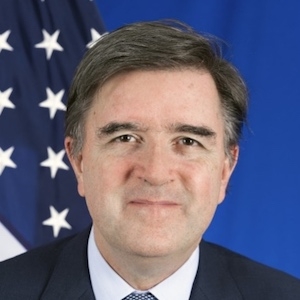
On March 17, Ambassador James C. O’Brien, head of the U.S. Office of Sanctions Coordination, spoke at the Jewelers Vigilance Committee (JVC) luncheon, where he made it clear that the U.S. government, in cooperation with other G7 nations, will tighten current Russian diamond sanctions.
“It is vitally important for us that we keep the pressure on [Russia] so that they’re not able to obtain [new military] equipment,” he told JVC president and CEO Tiffany Stevens. “We’re looking to find any pockets of revenue that are available to Russia. We know [Russian diamond miner] Alrosa is deeply integrated into the power structures in Russia, and last year there was money siphoned from Alrosa to subsidize certain military events.”
In the future, “we’d like to say that the G7 markets won’t accept diamonds that come from Russia,” O’Brien added. “That could mean a declaration that has to be verified that diamonds being imported into the U.S. don’t have Russian origin. And there may be some other options.…
“There are technical questions—what size stones [would be subject to sanctions], and how long we would have to wait for the Russian stones to be flushed out of international commerce—we’ll talk to [industry] about those issues, and ultimately have a way forward. But having the overall framework and process in place by [the G7 meeting in] mid-May is at least my goal.”
Afterward, Ambassador O’Brien spoke with JCK about what sanctions he’d like to see, and what will happen to companies that don’t comply:
You mentioned that in mid-May, President Biden will meet with the rest of the G7 nations, and they’ll want to follow up on the comment about Russian diamonds they made in February. In the United States, Russian diamonds are currently allowed in the country if they are cut and polished elsewhere. Will that change?
What we want is to have no Russian diamonds coming into our market.
That can be accomplished in a lot of different ways, and that is what we’re consulting with industry about.
But when you say Russian diamonds, you mean no Russian-mined diamonds?
Yes, diamonds that came out of the earth in Russia. So, no amount of polishing will be able to wash off that Russian origin.
You mentioned that you want importers to make “declarations” about a diamond’s non-Russian origin. What kinds of declarations will you be looking for, and what kind of backup would be needed?
What we want to do, with industry, is look at experience in similar areas, such as the requirements for gemstones [e.g., sanctions against Burmese rubies], or the experience of the Kimberley Process, and see how that can be adapted here, or whether we need to do something new.
This affirmative declaration, will it require some kind of paper trail or scientific backup?
That’s what we’re consulting about.
Will there be a size cutoff, at least initially? Will this apply to all sizes of diamonds?
We’re looking at what the right size [cutoff] is. I don’t think we’ve settled on that.
If the declarations are false, or not there, what kind of penalties would people be subject to?
Lying to the U.S. Customs is not a good idea. We enforce our customs requirements, we enforce our sanctions. At that point, it’s a normal matter of stopping people from evading the rules.
Assuming a plan is agreed to at the G7 meeting in May, when do you expect it to go into effect?
One of the ways we need to look closely at is how quickly this can be put in place without creating opportunities for evasion.
What kind of reaction have you gotten from Indian manufacturers?
We’re consulting the Indian industry. We plan to have a consultation [this] week. The early signs are, what they want to know is, what are the rules to continue to export into the G7 markets? If we set clear rules of what we expect, I think they will find a way to comply with those rules.
You have mentioned the gemstone bans and the Kimberley Process. Enforcement has been spotty for both of those. What lessons have you learned from them?
In this case, what will help is that we’re talking about the seven largest economies, and the largest importers of diamonds, all together, putting in place an importation ban at the same time. And that’s a pretty significant difference than the way these other processes came about.
In the diamond industry—unlike, say, gemstones—there’s a number of large players who seem very interested in complying with the rules. So, I think there’s a center of gravity, both in the markets and the industry, that will make this a different experience. And we’ll learn whatever lessons there are from those other experiences.
Small-scale (artisanal) miners often say that, unlike large mining companies, they don’t have the ability to give proof of origin. How will you handle that?
That’s a topic we’ll take a look at. The focus here is elsewhere, and we try to avoid unintended consequences.
What effect have the Russian diamond sanctions had so far?
Alrosa has certainly seen its market share affected by its [sanctioned] designation. But the reason we want to take this next step is to maximize the pressure.
(Photo courtesy of the Jewelers Vigilance Committee)
- Subscribe to the JCK News Daily
- Subscribe to the JCK Special Report
- Follow JCK on Instagram: @jckmagazine
- Follow JCK on X: @jckmagazine
- Follow JCK on Facebook: @jckmagazine






